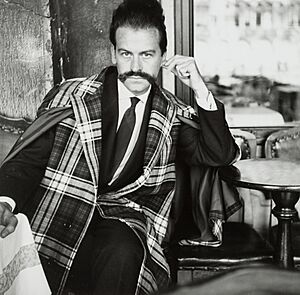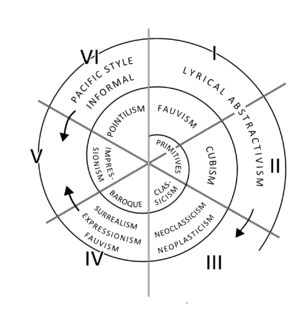Georges Mathieu facts for kids
Quick facts for kids
Georges Mathieu
|
|
|---|---|
 |
|
| Born | 27 January 1921 |
| Died | 10 June 2012 (aged 91) |
| Resting place | Montmartre Cemetery |
| Nationality | French |
| Known for | Painting, writing |
|
Notable work
|
La Bataille de Bouvines (1954), Hommage au Maréchal de Turenne (1952) |
| Movement | Lyrical abstraction, Tachisme |
Georges Mathieu (born January 27, 1921 – died June 10, 2012) was a famous French artist. He was known for his abstract paintings, which means his art didn't show real-life objects or people. He was also an art thinker and a member of the important Académie des Beaux-Arts in Paris. Many people see him as one of the main artists who started a style called Lyrical abstraction in Europe. This style is part of a bigger art movement called informalism, which focuses on the artist's feelings and actions.
Contents
Georges Mathieu's Life Story
Early Life and School Days
Georges Mathieu was born in 1921 in a French city called Boulogne-sur-Mer. His dad worked as a bank manager, and his mom taught him how to draw when he was little. When he was 12, his parents divorced, and he went to live with his aunt in Versailles.
He went to different schools and later studied English and law at the University of Lille. After finishing school, he worked as an English teacher in France. He also worked as an interpreter for the American Army in 1944.
In 1942, Georges Mathieu started painting pictures of England from postcards. But by 1944, he had a big idea: he realized that paintings didn't need to show real things to be art. This led him to create his first abstract painting, which he called Inception.
Working for United States Lines
In 1947, Mathieu moved to Paris. He got a job with the United States Lines, a shipping company. His job was to welcome and help travelers on the ships between New York City and Le Havre. This job helped him meet many important people, including the famous artist Salvador Dalí.
From 1953 to 1963, Mathieu was the main editor for the United States Lines Paris Revue, a magazine. This magazine was given out for free and allowed him to interview many famous people. He talked to artists like John Cage and Mark Tobey, and even scientists like Albert Einstein.
First Art Shows
Georges Mathieu's first abstract paintings were shown in Paris in 1946. He then helped start an art group called L’Imaginaire with other artists like Wols and Jean-Michel Atlan. They had an exhibition in 1947 called Towards Lyrical Abstraction.
This group grew bigger and helped create the idea of Lyrical Abstraction. This art style was all about being free from traditional ways of painting. In 1948, Mathieu also helped introduce American abstract artists like Jackson Pollock to the French art world. He started painting very large artworks in 1952.
Becoming Famous
Starting in 1957, Georges Mathieu traveled a lot. He painted in Japan, the USA, Brazil, and the Middle East. People began to hold special shows of his work as early as 1959.
In 1965, Mathieu had a huge show at the Galerie Charpentier in Paris. For this event, he painted a giant artwork called Paris, Capitale des Arts. It featured bright colors on a blue background. Later, in 1978, an even bigger show of his art was held at the Grand Palais. He created seven massive paintings just for this show.
Mathieu received important awards like the Legion of Honour. His artworks are now displayed in more than 90 museums around the world.
Joining the Academie des Beaux-Arts
In 1976, Georges Mathieu became a member of the Academie des Beaux-Arts. This is a very respected group of artists in France. He held a special seat in the painting section.
Helping Public Culture and Education
Mathieu believed that art should be a bigger part of cities and everyday life. He also thought that schools should teach more about art. He wanted art history, drawing, and music to be required subjects in French schools. He even worked with politicians to try and make this happen, but his plan was not approved in 1980.
Georges Mathieu passed away on June 10, 2012, when he was 91 years old. He is buried in the Montmartre Cemetery in Paris.
What is Lyrical Abstraction?
From 1947, Georges Mathieu wrote about his ideas for Lyrical abstraction. He said there were four main rules for this art style:
- Paint quickly: The artist should paint very fast. This helps to stop the artist's conscious thoughts from getting in the way.
- No old shapes: The painter should not use any shapes or ideas that already exist.
- No planned moves: Painting should not be something the artist thinks about too much beforehand.
- Artist's happy state: The artist should be focused and feel excited. This helps the art flow freely.
Mathieu believed that Lyrical abstraction was the newest big change in art history. He thought that art was becoming free from showing real things. First, Impressionism freed art from realism. Then, Cubism freed it from traditional shapes. Finally, geometric abstraction freed art from showing things you could see. Mathieu's Lyrical abstraction aimed to free art from all past rules and references from nature.
Amazing Artworks and Performances
Painting in Public
Georges Mathieu loved to paint in front of people. He said, "Few understood that painting in public represents for me a true communion amongst men." These public performances, sometimes called happenings, showed how fast and skilled he was. In 1956, he painted a huge artwork, 400x1200cm, in front of 2,000 people! He used more than 800 tubes of paint for this piece, called Hommage aux poètes du monde entier. Many of his performances were filmed, like one for Canadian television in 1963.
He also created sculptures and used light to paint.
Painting Style and Speed
Mathieu used brushes, cloths, or even painted directly from the paint tube. He was one of the first artists to use "dripping" techniques in some of his early works, like Evanescence in 1945.
His super-fast painting became his special style. In 1959, he painted a 2.5x6 meter artwork called Le Massacre de la Saint-Barthélemy in less than 30 minutes! He did this while the jazz drummer Kenny Clarke played music. He explained that he painted fast not to break records, but because he didn't need more time. Painting slower would have made his strokes less pure.
He sometimes wore special outfits during his performances. Many of his most important paintings and writings were created on Sundays. Mathieu also loved to paint on very large canvases. He felt that bigger canvases meant a bigger challenge and allowed him to use wide, sweeping movements.
| Title | Year | Dimensions |
|---|---|---|
| Flamence rouge | 1950 | 250x200cm |
| Les Capétiens partout | 1954 | 300x600cm |
| La Bataille de Goya | 1957 | 150x1500cm |
| Hommage aux poètes du monde entier | 1956 | 400x1200cm |
| La Victoire de Denain | 1963 | 275x700cm |
| Paris Capitale des Arts | 1965 | 300x900cm |
How His Style Changed
Informalism
Mathieu's first abstract paintings had organic shapes. These shapes didn't mean anything specific. Some of his early painting methods were similar to what Jackson Pollock would do two years later, which led to the style called Action Painting.
Tachisme
By 1950, his paint drips became stronger and gathered around a center. He used mostly warm colors. From 1951, Mathieu explored a style called Tachisme on single-color canvases. This style involved blobs of paint, often created by hitting the canvas with the brush. Examples include Le Maréchal de Turenne and La Bataille de Bouvines.
Lyrical Abstraction
In the 1960s, Mathieu's "zen period" paintings had only a few strokes on a single-color background. This showed the power of simple marks. Examples are La Bataille de Brunkerberg. In the 1970s, he focused on balancing central shapes with uniform blocks of color.
From 1984, Mathieu's paintings changed again. He called this a "cosmic turning point." His artworks no longer had a single center. Instead, many shapes and lines spread across the canvas, creating balance through their tension.
Painting Titles
Georges Mathieu loved history, especially the Middle Ages. Because of this, many of his paintings were named after historical battles or events. Some examples are La Bataille de Bouvines (The Battle of Bouvines) and La Victoire de Denain (The Victory of Denain).
However, Mathieu always said that his paintings did not actually show these historical events. He did admit that he sometimes chose titles based on where he painted the artwork, the day he painted it, or the feeling of the painting. For example, Hommage au général Hideyoshi was named after a general.
Other titles were inspired by math (Théorème d'Alexandrov), physics (Le principe de Pauli), or philosophy (Grand algorithme blanc).
Other Creative Contributions
Throughout his life, Mathieu worked to bring art into modern society. He used his unique style in many different areas.
City Planning and Buildings
In 1964, Mathieu helped create architectural plans for a city called Castellas. In 1966, he designed the plans for an electrical factory in Fontenay-le-Comte.
Tapestries and Porcelain
Mathieu felt that traditional crafts hadn't changed much in the 20th century. So, he worked with famous French factories. In 1966, he joined the Manufacture nationale de Sèvres and created his own series of porcelain plates. He also made many tapestries with the Manufacture nationale des Gobelins in Paris.
Stamp Designs
Some of Georges Mathieu's artworks were used as designs for national stamps. In 1972, he designed his first stamp for the Indian post office. Later, in 1974, a stamp featuring his tapestry Hommage à Nicolas Fouquet was released. In 1980, he created another stamp to celebrate the 40th anniversary of the Battle of France.
Coin Design
In 1973, there was a competition to design a new ten-franc coin for France. Mathieu was asked to join. His design showed French industry on one side and a hexagonal shape of France on the other. His design was chosen in 1974, and over 100 million of these coins were made between 1974 and 1987.
Advertising Work
Mathieu also worked on several advertising campaigns. In 1966, Air France asked him to create a series of posters for their ads. These posters showed different travel destinations like New York and Japan in his lyrical abstraction style.
The French television awards, Les 7 d'or, gave out statues designed by Mathieu to the winners from 1985 to 2001. The Champagne company Deutz also created special Champagne bottles decorated by Mathieu.
His Artistic Impact
The Gutai group of Japanese artists was inspired by Mathieu's live performances in the 1950s. In their 1956 statement, they said they admired Mathieu because his art seemed to be "cries uttered out of matter, pigment and enamel." They felt he merged with his materials in a powerful way.
Some of Mathieu's works also seemed to predict the modern style of Graffiti.
See also
 In Spanish: Georges Mathieu para niños
In Spanish: Georges Mathieu para niños
- Lyrical Abstraction
- French art
- Tachisme
- Groupe Gutaï
- Michel Tapié



